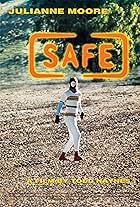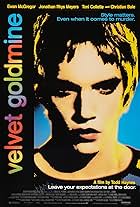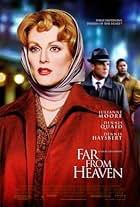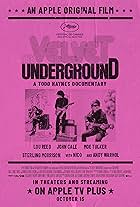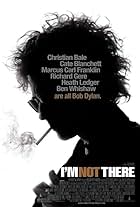A boy shoots his father and flies out the window. A man falls in love with a fellow inmate in prison. A doctor accidentally ingests his experimental sex serum, wreaking havoc on the communit... Read allA boy shoots his father and flies out the window. A man falls in love with a fellow inmate in prison. A doctor accidentally ingests his experimental sex serum, wreaking havoc on the community.A boy shoots his father and flies out the window. A man falls in love with a fellow inmate in prison. A doctor accidentally ingests his experimental sex serum, wreaking havoc on the community.
- Awards
- 4 wins & 6 nominations
- Nancy Olsen (segment "Horror")
- (as Susan Gayle Norman)
- Director
- Writers
- All cast & crew
- Production, box office & more at IMDbPro
Storyline
Did you know
- TriviaThe film received a $25,000 completion grant from the National Endowment of the Arts. This caught the attention of Republican senator Jesse Helms, who in spite of not having seen the film declared it an abomination and a waste of taxpayer money.
- GoofsA man runs past the bedroom window during the second interview with Gregory Lazar.
- Quotes
John Broom: [V.O] Prison was not new to me. I'd lived in them all my life. In submitting to prison life, embracing it... I could reject the world that had rejected me.
- Alternate versionsEdited, "R" rated version is available on video.
- ConnectionsFeatured in The Celluloid Closet (1995)
In a general sense, the film is inspired by the writings of Jean Genet (1910-1986), a French author associated with the existentialist movement. A deliberate outsider, Genet spent so much of his youth in and out of prison that he was ultimately threatened with a life sentence as a habitual criminal. In his writings, Genet fused his homosexual, criminal, and prison adventures into a consistent point of view--one that championed freedom of choice (no matter how unattractive the choice), self-determination (no matter how unfortunate the result), and generally gave the finger to any form of authority (no matter how necessary.) POISON specifically references three of his most celebrated works: OUR LADY OF THE FLOWERS, THE MIRACLE OF THE ROSE, and THE THIEF'S JOURNAL, all of which were to some extent autobiographical.
At the same time, the film also references a host of other films--so many that it is sometimes difficult to know whether a single reference is deliberate or simply a fluke, an effect that Genet himself would have likely admired. The most obvious of these references is D.W. Griffith's 1916 silent masterpiece INTOLERANCE, for like that film POISON tells three distinctly stories, cross-cutting between them that they might heighten each other. Unlike INTOLERANCE, however, each story is also told in a distinctly different cinematic style, and these too seem to reference various other films.
The first of these stories, HOMO, is very specifically drawn from Genet. It tells the story of a constant criminal and homosexual who, while in prison, meets a man whose repeated sexual humiliation he witnessed when both were children in a reformatory. He forces the man, who is unwilling mainly due to fear than from morality, into an emotional relationship and later rapes him. The "present" sequences are shot in a murky half-light, the prison presented as a labyrinth of potential sexual destruction. When the prisoner recalls his youthful past, however, the tone changes to a surrealistic and extremely artificial beauty--not unlike that seen in such films as James Bidgood's PINK NARCISSUS and Fassbinder's QUERELLE. It is worth pointing out that these different styles are ironic in use: although shot darkly, the events of the "present" sequence are only mildly shocking in comparison with the events of the "past" sequence, which is shot in a bright and rather romantic style.
HORROR references the 1950s and early 1960s cinematic style of such "B" directors as William Castle and Roger Corman, and it frequently borrows cinematic ideas from Rod Sterling's television series THE TWILIGHT ZONE. In this particular tale, a scientist has labored to isolate the essence of the human sex drive--and succeeds only to ingest the element by accident. With human sex drive raging out of control in his body, he develops oozing sores, and his physical contacts with others spread the condition. It is difficult not to read this as a reference to the AIDS epidemic.
The third story, HERO, is actually presented very much like a modern television news story and is told through a series of interviews. Here, a young boy has shot his father--and then, according to his mother, leaps from the window sill and simply flies away. Neighbors comment: the boy exposed himself. School teachers comment: the boy was unnatural, the boy was normal, the boy was creative, the boy was a liar. A doctor comments: it is possible the boy had a, er, disease of the genitals. As the story progresses the layers add up--but it leaves us without clearcut answers, much less a clearcut response, and in this last respect it is exactly like the other two stories.
It is extremely, extremely difficult to know how to react to POISON. It has moments of remarkable beauty, but these are coupled with moments of equally remarkably off-putting disgust. It is often an erotic film, but the eroticism is tinged and occasionally saturated with revulsion. And in all of this it is remarkably true to its original source: Genet, whose works typically provoke exactly the same sense of beauty, disgust, sensuality, revulsion, and uncertainty of response. I cannot say that I like POISON, which was the directorial debut of Todd Haynes, presently best known for FAR FROM HEAVEN--but then, it is not that sort of film; it does not invite you like it, but rather to consider it both in whole and in part. It strives to be interesting, and in that it is often quite successful.
Unfortunately, it may also be a little too interesting for its own good. While it certainly has its visceral moments, occasionally to the gag point, it asks us to solve a puzzle from which pieces are missing. This not a necessarily a bad thing, but in the case of POISON too many pieces have gone astray; it seems deliberately unsolvable. This may actually be intentional, but if so it was a mistake. A sense of mystery is one thing, but mystification is another, and given its overall strangeness--not to mention the subject matter--I think it very, very unlikely that it will ever have more than curiosity appeal outside an art house audience.
GFT, Amazon Reviewer
- How long is Poison?Powered by Alexa
Details
Box office
- Budget
- $250,000 (estimated)
- Gross US & Canada
- $787,280
- Gross worldwide
- $787,280
- Runtime1 hour 25 minutes
- Color
- Sound mix
- Aspect ratio
- 1.66 : 1
Contribute to this page














